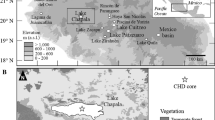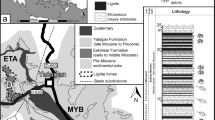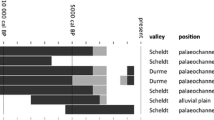Abstract
Pollen analysis of 5 wells drilled to bedrock in the Great Salt Lake, Utah, USA provide a record vegetation change over the last ca 13.5 Ma. Over 440 pollen samples have been counted. The longest record presented is for the mid-lake Bridge Well. Close-interval (3–10 Ka) sampling is presented for the upper Indian Cove well. Chronologic control is provided by identification volcanic tephra and by K/Ar, Ar/Ar, and fission-track dates. Ash determinations are based on electron microprobe analyses of iron, calcium, and other elements compared to Neogene ash data at the University of Utah. Sedimentation begins 38 Ma, with good pollen preservation is sediments younger than 13.5 Ma, and no obvious gaps in sedimentation after 6 Ma.
The upland vegetation is desert from the late Miocene onward, with Sarcobatus and Ephedra pollen dominance during the late Miocene (<5 Ma). Chenopodiaceae-Amaranthus, and Artemisia gain dominance during the Pliocene (5–2.5 Ma) and early Pleistocene. Pinus and Artemisia sharply increase in the late Pleistocene (0.75 Ma). The pollen of 'Tertiary exotics' (elm, hickory, Ostrya-Carpinus) is rare, but persists into the Pleistocene. Major vegetation – climatic events occur 3.7 and 2.5 Ma. Increased pollen concentration and sedimentation rate after 310 Ka are attributed to the diversion of the Bear River into the Bonneville Basin.
Glacial-interglacial cycles appear as alternations of Chenopodiaceae-Amaranthus (interglacial) vs Artemisia (glacial) during the Pliocene and early Pleistocene, and of Cupressaceae, Sarcobatus, and Gramineae (interglacial) vs Picea, Abies, and Pseudotsuga (glacial) during the late Pleistocene. Pluvial cycles are separated by interpluvial peaks in percentages of wetground and aquatic types. Six interpluvials are indicated during the last 759 Ka, with pluvial cycles of ca 100 Ka cyclicity back to 1.5 Ma.
Similar content being viewed by others
References
Antevs, E., 1955. Geologic-climatic dating in the west. American Antiquity 20: 317–355.
Axelrod, D. I., 1950. The evolution of desert vegetation in western North America. Carnegie Inst. Wash. Publ. 590: 215–306.
Axelrod, D. I., 1957. Late Tertiary floras and the Sierra Nevada uplift. Bull. Geol. Soc. Am. 68: 19–46.
Axelrod, D. I., 1979. Age and origin of Sonoran Desert Vegetation. California Academy of Sciences Occasional Papers 132: 1–74.
Axelrod, D. I. & H. P. Bailey, 1969. Paleotemperature analysis of tertiary floras. Palaeogeogr. Palaeoclimat. Palaeoecol. 6: 163–195.
Barnosky, C. W., 1984. Late Miocene vegetational and climatic variations inferred from a pollen record in Northwest Wyoming. Science 223: 49–51.
Bortz, L. C., S. A. Cook. & O. J. Morrison, 1985. Great Salt Lake Area, Utah. In Gries, R. R. & R. C. Dyer (eds), Seismic Exploration of the Rocky Mountain Region. Rocky Mountain Association of Petroleum Geologists and Denver Geophysical Society.
Bright, R. C., 1967. Late-Pleistocene stratigraphy in Thatcher Basin, southeastern Idaho. Tebiwa 10: 1–7.
Constenius, K. N., 1996. Late Paleogene extensional collapse of the Cordilleran foreland fold and thrust belt. G.S.A. Bull. 108: 20–39.
Currey, D. R., 1990. Quaternary paleolakes in the evolution of semi-desert basins, with special emphasis on Lake Bonneville and the Great Basin. Palaeogeogr. Palaeoclimat. Palaeoecol. 76: 189–214.
Davis, O. K., 1995. Climate and vegetation patterns in surface samples from arid western USA: Application to Holocene climatic reconstructions. Palynology 19: 97–120.
Dunn, T. L., 1980. Rozel point area basalts: fractures and correlations with subsurface rocks, Salt Lake, Utah. Unpublished report to Amoco Production Company.
Eardley, A. J., R. T. Shuey, V. Gvosdetsky, W. P. Nash, M. D. Picard, D. C. Grey & G. J. Kukla, 1973. Lake cycles in the Bonneville basin, Utah. Geol. Soc. Am. Bull. 87: 211–216.
Gilbert, G. K., 1885. The topographic features of lake shores. U.S.G.S. Annual Report 5B: 69–123.
Grimm, E. C., 1987. CONISS: A FORTRAN 77 program for stratigraphically constrained cluster analysis by the method of incremental sum of squares. Computers and Geosciences 13: 13–35.
Leopold, E. B. & M. F. Denton, 1987. Comparative age of grassland and steppe east and west of the northern Rocky Mountains. Ann. Missouri Bot. Gard. 74: 841–867.
Oviatt, C. G., W. D. McCoy & R. G. Richard, 1987. Evidence for a shallow early or middle Wisconsinage lake in the Bonneville Basin, Utah. Quat. Res. 27: 248–262.
Martinson, D. G., N. G. Pisias, J. D. Hays, J. Imbrie, T. C. Moore, Jr. & N. G. Shackleton, 1987. Age dating and orbital theory of the ice ages: development of a highresolution 0 – 300 000year chronostratigraphy. Quat. Res. 27: 1–29.
Mehringer, P. J., Jr., 1985. Late-Quaternary pollen records from the interior Pacific Northwest and northern Great Basin of the United States. In Bryant, V. M. & R. M. Holloway (eds), Pollen records of Late-Quaternary North American sediments. AASP Foundation, 168–189.
Meyer, L., N. Pisias, T. Janecek et al., 1992. In Proceedings of the Ocean Drilling Program, Initial Reports. Vol. 138: 265–333.
Morrison, R. B., 1987. Quaternary stratigraphic, hydrologic and climatic history of the Great Basin, with emphasis on lakes Lahontan, Bonneville, and Tecopa. In Morrison R.B. (ed.), Quaternary nonglacial geology: Conterminous US. Geology of North America, V. K2. Geol. Soc. Am. 283–320.
Moutoux, T. E., 1995. Palynological and tephra correlations among deep wells in the Modern Great Salt Lake, Utah, USA. M.S. thesis. Univ. Arizona, Tucson: 30 pp.
Moutoux, T. E. & O. K. Davis, 1995. Neogene through Pleistocene paleoclimate of the Great Salt Lake region, Northeastern Great Basin, USA. Calif. Dept. Water Res. Ecol. Stud. Progr. Techn. Rep. 40: 127–135.
Moutoux, T. E., O. K. Davis, M. Perkins & W. P. Nash, in preparation. Palynological and tephra correlations among deep wells in the Modern Great Salt Lake, Utah, USA. G.S.A. Bulletin.
Naesser, C. W., B. Bryant, M. D. Crittenden, Jr. & M. L. Sorensen, 1983. Fission-track ages of apatite in the Wasatch Mountains, Utah: An uplift study. Geol. Soc. Am., Memoir 157: 29–36.
Spencer, R. J., M. J. Baedecker, J. P. Eugster, R. M. Forester, M. B. Goldhaber, B. F. Jones, K. Kelts, J. Mckenzie, D. B. Madsen, S. L. Rettig, M. Rubin & C. J. Bowser, 1984. Great Salt Lake and precursors Utah: The last 30 000 years. Contributions to Mineralogy and Petrology 86: 321–334.
Thompson, R. S., 1991. Pliocene environments and climates in the western United States. Quat. Sci. Rev. 10: 115–132.
Tiedmann, R., M. Sarnthein & N. J. Shackleton, 1994. Astronomic timescale for the Pliocene Atlantic δ18O and dust flux records of Ocean Drilling Program site 659. Paleoceanogr. 9: 619–638.
Williams, S. K., 1993. Tephrochronology and Basinal Correlation of ash deposits in the Bonneville Basin, northwest Utah. M.S. thesis, University of Utah, Salt Lake City, 104 pp.
Author information
Authors and Affiliations
Rights and permissions
About this article
Cite this article
Davis, O.K., Moutoux, T.E. Tertiary and Quaternary vegetation history of the Great Salt Lake, Utah, USA. Journal of Paleolimnology 19, 417–427 (1998). https://doi.org/10.1023/A:1007959203433
Issue Date:
DOI: https://doi.org/10.1023/A:1007959203433




